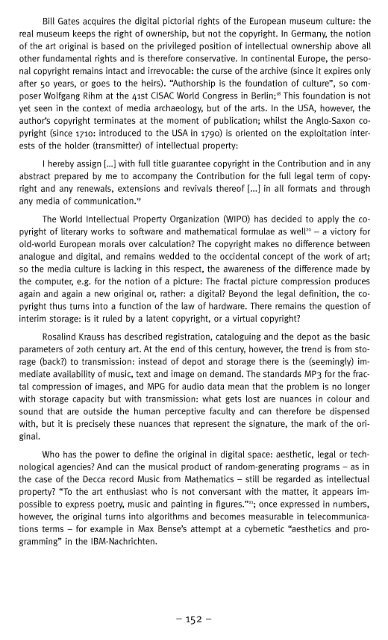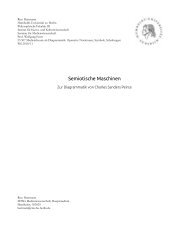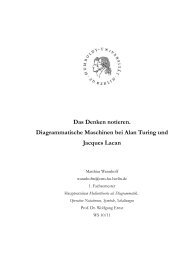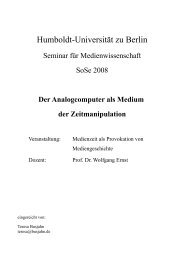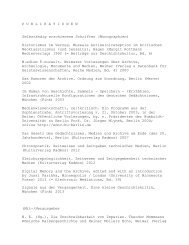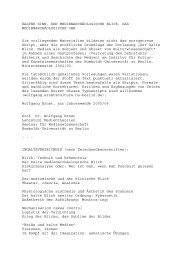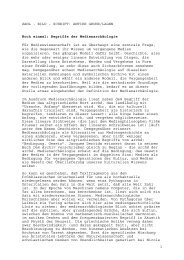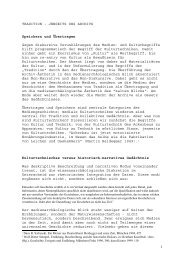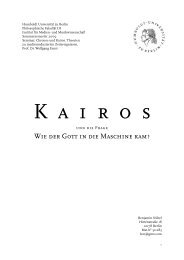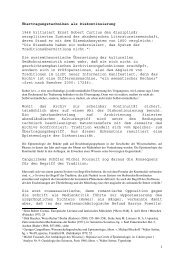Download - Medienwissenschaft
Download - Medienwissenschaft
Download - Medienwissenschaft
Create successful ePaper yourself
Turn your PDF publications into a flip-book with our unique Google optimized e-Paper software.
Bill Gates acquires the digital pictorial rights of the European museum culture: the<br />
real museum keeps the right of ownership, but not the copyright. In Germany, the notion<br />
of the art original is based on the privileged position of intellectual ownership above all<br />
other fundamental rights and is therefore conservative. In continental Europe, the personal<br />
copyright remains intact and irrevocable: the curse of the archive (since it expires only<br />
after 50 years, or goes to the heirs). "Authorship is the foundation of culture", so composer<br />
Wolfgang Rihm at the 41st CISAC World Congress in Berlin; 18 This foundation is not<br />
yet seen in the context of media archaeology, but of the arts. In the USA, however, the<br />
author's copyright terminates at the moment of publication; whilst the Anglo-Saxon copyright<br />
(since 1710: introduced to the USA in 1790) is oriented on the exploitation interests<br />
of the holder (transmitter) of intellectual property:<br />
I hereby assign [...] with full title guarantee copyright in the Contribution and in any<br />
abstract prepared by me to accompany the Contribution for the full legal term of copyright<br />
and any renewals, extensions and revivals thereof [...] in all formats and through<br />
any media of communication. 19<br />
The World Intellectual Property Organization (WIPO) has decided to apply the copyright<br />
of literary works to software and mathematical formulae as well 20 - a victory for<br />
old-world European morals over calculation? The copyright makes no difference between<br />
analogue and digital, and remains wedded to the occidental concept of the work of art;<br />
so the media culture is lacking in this respect, the awareness of the difference made by<br />
the computer, e.g. for the notion of a picture: The fractal picture compression produces<br />
again and again a new original or, rather: a digital? Beyond the legal definition, the copyright<br />
thus turns into a function of the law of hardware. There remains the question of<br />
interim storage: is it ruled by a latent copyright, or a virtual copyright?<br />
Rosalind Krauss has described registration, cataloguing and the depot as the basic<br />
parameters of 20th century art. At the end of this century, however, the trend is from storage<br />
(back?) to transmission: instead of depot and storage there is the (seemingly) immediate<br />
availability of music, text and image on demand. The standards MP3 for the fractal<br />
compression of images, and MPG for audio data mean that the problem is no longer<br />
with storage capacity but with transmission: what gets lost are nuances in colour and<br />
sound that are outside the human perceptive faculty and can therefore be dispensed<br />
with, but it is precisely these nuances that represent the signature, the mark of the original.<br />
Who has the power to define the original in digital space: aesthetic, legal or technological<br />
agencies? And can the musical product of random-generating programs - as in<br />
the case of the Decca record Music from Mathematics - still be regarded as intellectual<br />
property? "To the art enthusiast who is not conversant with the matter, it appears impossible<br />
to express poetry, music and painting in figures." 21 ; once expressed in numbers,<br />
however, the original turns into algorithms and becomes measurable in telecommunications<br />
terms - for example in Max Bense's attempt at a cybernetic "aesthetics and programming"<br />
in the IBM-Nachrichten.<br />
-152-


